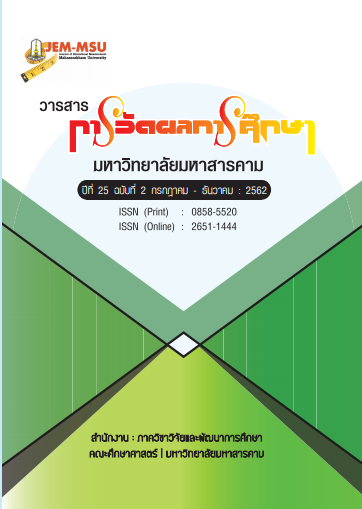Development of a Multimedia Measuring Instrument for the Desirable Characteristic of Work Commitment of Grade 6 Students under Surin Primary Educational Service Area Office 2
Main Article Content
Abstract
This research aimed to 1) construct and find the quality of the multimedia measuring instrument for the desirable characteristic of work commitment of grade 6 students under Surin Primary Educational Service Area Office 2, and 2) create norms for interpretation of the scores obtained from using the measuring instrument for the desirable characteristic of work commitment of grade 6 students under Surin Primary Educational Service Area Office 2. The sample in this research consisted of 440 grade 6 students from 17 schools under Surin Primary Educational Service Area Office 2, obtained through multi-stage random sampling. The instrument used was a measuring instrument for the desirable characteristic of work commitment. For each item, a situation was given and the student was to choose the answer from the 4 choices given. The instrument contained 25 items. It was constructed in 2 formats, multimedia and traditional. Each format was used 3 times in the experiment; in the 1st and the 2nd time each had a sample of 60 students in order to analyze and find the discrimination of each item for improvement. In the 3rd time a sample of 100 students was used in order to find the reliability and create norms in the form of T-score. Then the T-score was extrapolated by using the predictive equation.
The results of the research revealed the following:
1. The construction of the measuring instrument for the desirable characteristic of work commitment yielded 2 main indicators: 1) intention and responsibility in doing work, and 2) working with perseverance and patience in order to meet the goal.
The results of finding the quality of the measuring instrument revealed that:
2.1. In the first pilot test, the item discrimination (rxy ) of the multimedia format, after the statistical significance had been tested, had the statistical significance at the .05 level; 27 out of 30 items met the criterion. All the usable items were kept, and their item discrimination (rxy ) ranged from .23 to .62. They were to be used in the second test.
For the traditional format, 28 out of 30 items met the criterion. All the usable items were kept, and their item discrimination (rxy ) ranged from .23 to .70. They were to be used in the second test.
2.2 In the 2nd test, the item discrimination (rxy ) of the multimedia format, after the statistical significance had been tested, had the statistical significance at the .05 level; 27 items met the criterion; 25 items were kept, and their item discrimination (rxy ) ranged from .32 to .79, and the total reliability was .90. They were to be used in the third test.
For the traditional format, 28 items met the criterion; 25 items were kept, and their item discrimination (rxy ) ranged from .32 to .82. The total reliability was .91. They were to be used in the third test.
2.3 In the 3rd test, the multimedia measuring instrument for the desirable characteristic of work commitment of grade 6 students containing 25 items had item discrimination (rxy ) ranging from .21 to .64, and the total reliability was .86.
For the traditional format which contained 25 items, it had the item discrimination (rxy ) ranging from .23 to .67, and the total reliability was .89.
For the traditional format which contained 25 items, it had the item discrimination (rxy ) ranging from .23 to .67, and the total reliability was .89.
3. The norms and T-score which was extrapolated by using the predictive equation of the multimedia measuring instrument for the desirable characteristic of work commitment of grade 6 students had the lowest T and the highest T from T24 to T73
Article Details
The content and information contained in the published article in the Journal of Educational Measurement Mahasarakham University represent the opinions and responsibilities of the authors directly. The editorial board of the journal is not necessarily in agreement with or responsible for any of the content.
The articles, data, content, images, etc. that have been published in the Journal of Educational Measurement Mahasarakham University are copyrighted by the journal. If any individual or organization wishes to reproduce or perform any actions involving the entirety or any part of the content, they must obtain written permission from the Journal of Educational Measurement Mahasarakham University.
References
ชุมนุมสหกรณ์การเกษตรแห่งประเทศไทย จำกัด
ชวาล แพรัตกุล และคณะ. (ม.ป.ป.). เทคนิคการเขียนข้อสอบ. กรุงเทพฯ : พิทักษ์อักษร
ทวีศักดิ์ กาญจนสุวรรณ. (2546). Multimedia ฉบับพื้นฐาน. กรุงเทพฯ: ไทยเจริญการพิมพ์,
เบญจลักษณ์ กุลวุฒิ. (2554). การสร้างแบบวัดคุณลักษณะอันพึงประสงค์ของนักเรียนชั้นประถมศึกษาปีที่ 3 สำนักงาน เขตพื้นที่การศึกษาประถมศึกษาศรีสะเกษเขต 3. วิทยานิพนธ์ กศ.ม.การวัดผลการศึกษา : มหาวิทยาลัยมหาสารคาม,
รัชภูมิ สมสมัย. (2552). การสร้างแบบประเมินคุณลักษณะอันพึงประสงค์ของผู้เรียนตามหลักสูตรแกนกลาง การศึกษาขั้นพื้นฐาน พุทธสักราช 2551. วิทยานิพนธ์ ศษ.ม. เชียงใหม่ :มหาวิทยาลัยเชียงใหม่,
เลอสันต์ ฤทธิขันธ์. (2556). การเปรียบเทียบผลการเรียนรู้ เรื่อง อักษรโบราณอีสานในหลักสูตรท้องถิ่นของ นักเรียนชั้นมัธยมศึกษาปีที่ 1 ระหว่างเรียนด้วยโปรแกรมบทเรียนแบบมัลติมีเดียกับการเรียนแบบ ปกติ.วิทยานิพนธ์ กศ.ม. เทคโนโลยีและสื่อสารการศึกษา : มหาวิทยาลัยมหาสารคาม,
ศิริพรรณ ไชยา. (2552). การสร้างแบบวัดคุณลักษณะความอ่อนน้อมถ่อมตน สำหรับนักเรียนช่วงชั้นที่ 3. วิทยานิพนธ์ กศ.ม.กรุงเทพฯ : มหาวิทยาลับศรีนครินทรวิโรฒ,
สราวุธ พันธ์พรหม. (2556). การสร้างแบบวัดคุณลักษณะอันพึงประสงค์ของนักเรียนชั้นประถมศึกษาปีที่ 6 ตามหลักสูตรแกนกลางการศึกษาขึ้นพื้นฐาน พุทธศักราช 2551. วิทยานิพนธ์ กศ.ม.การวัดผล การศึกษา : มหาวิทยาลัยมหาสารคาม,
สมนึก ภัททิยธนี. (2558). การวัดผลการศึกษา. พิมพ์ครั้งที่ 9. กาฬสินธุ์ : ประสานการพิมพ์.
สำนักรับรองมาตรฐานและประเมินคุณภาพการศึกษา. (2549).มาตรฐานการศึกษาและตัวบ่งชี้เพื่อการประเมิน ภายนอก ระดับการศึกษาขั้นพื้นฐาน รอบที่สอง (พ.ศ. 2549-2553).กรุงเทพฯ : ม.ป.พ.


